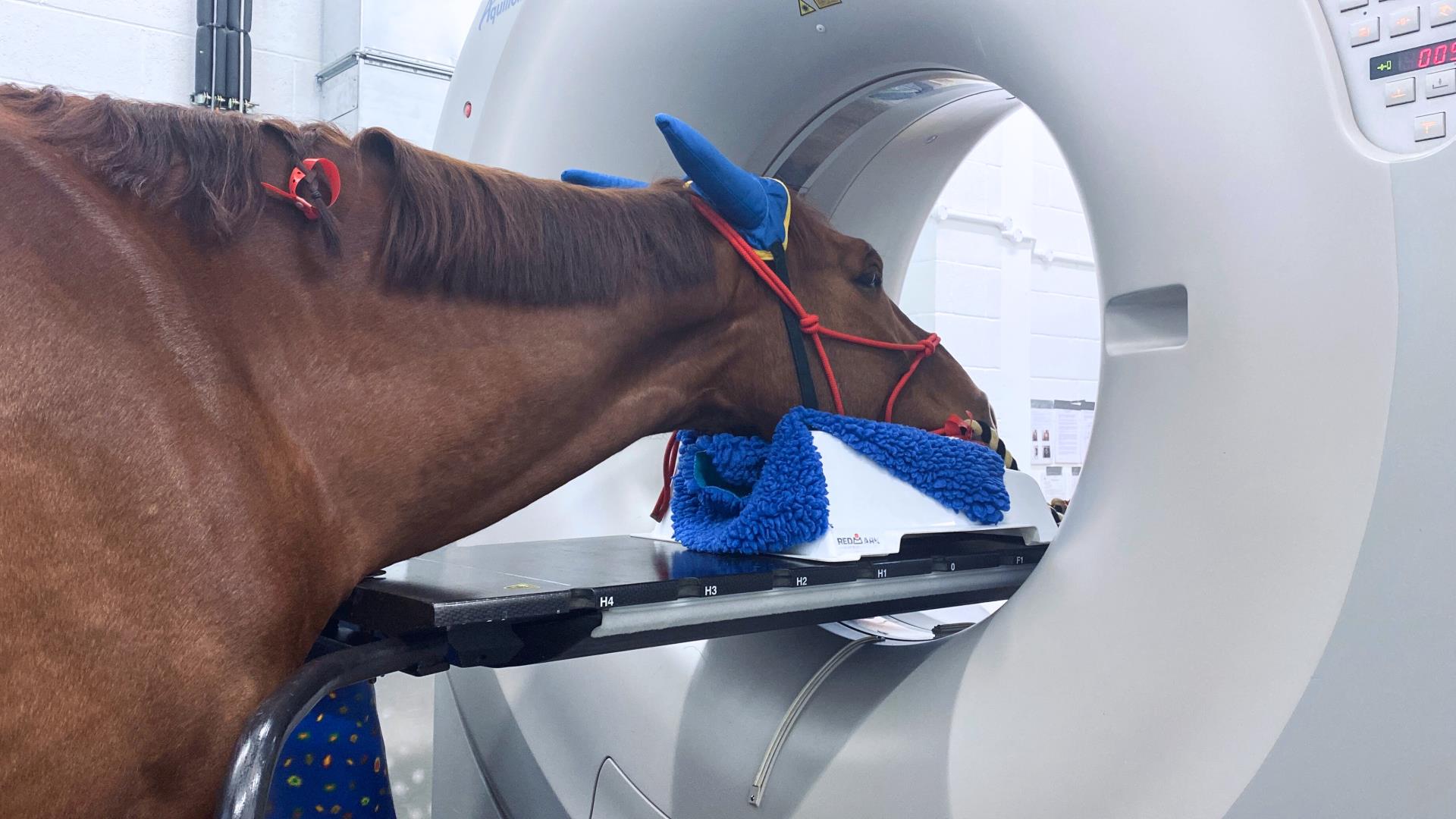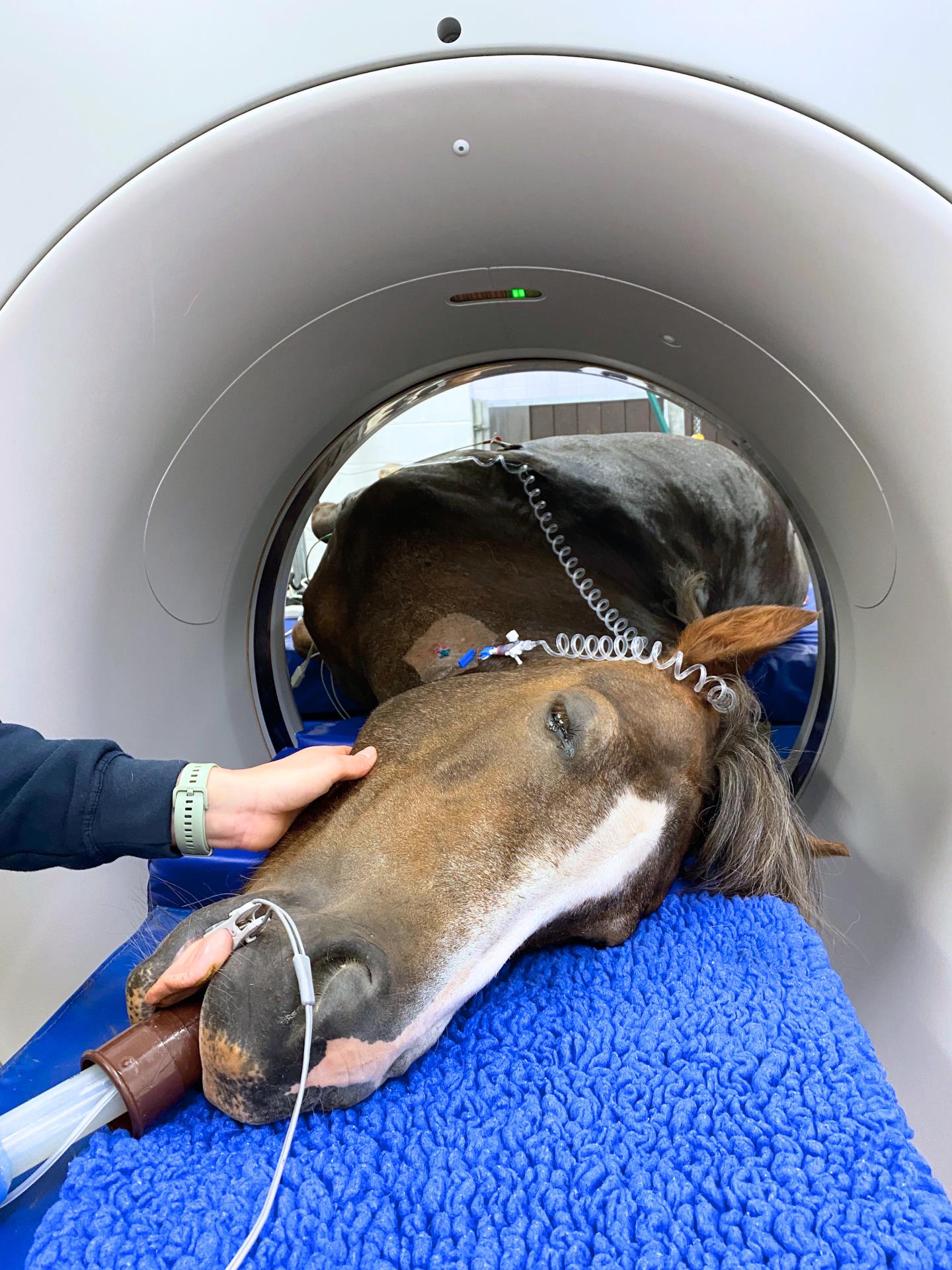Computed Tomography (CT) Scan
Computed Tomography (CT) is a sophisticated imaging technique that uses a rotating x-ray machine to produce high-resolution, cross-sectional images or ‘slices’ of a body part.
In horses, CT imaging is particularly useful for investigating diseases of the head, including dental abnormalities, sinus and nasal passage problems, traumatic injuries of the skull, headshaking and neurological diseases.
B&W Equine Hospital is one of only a select few equine hospitals in the UK that has the facilities to carry out CT imaging of the head in standing, sedated horses - avoiding the need for, and the potential risks associated with a general anaesthetic. The horse stands on a moving platform and the horses head passes through the circular CT scanner.
 There are several advantages of CT compared to conventional two-dimensional x-rays. In a CT scan adjacent structures are not superimposed on top of each other as they are in an x-ray making them much easier to isolate. Specialist computer software allows CT scanned images to be reformatted to create cross-sectional slices in multiple planes, and to produce three-dimensional reconstructions of the skull and teeth. This allows accurate diagnosis and can assist with surgical planning.
There are several advantages of CT compared to conventional two-dimensional x-rays. In a CT scan adjacent structures are not superimposed on top of each other as they are in an x-ray making them much easier to isolate. Specialist computer software allows CT scanned images to be reformatted to create cross-sectional slices in multiple planes, and to produce three-dimensional reconstructions of the skull and teeth. This allows accurate diagnosis and can assist with surgical planning.
CT scanning can be performed on an inpatient or outpatient basis.
CT scanning can assist in the diagnosis of dental or sinus disease
CT scanning produces a 3D image of the entire horses head from inside to out. Performed in the standing sedated horse it is particularly useful in diagnosing dental and sinus problems which may cause head pain, poor performance, loss of condition or nasal discharge. It can also be used in investigating upper neck pain.
CT scanning under general anaesthesia

As well as carrying out head CT scans in standing horses, B&W Equine Hospital is one of a small number of practices within the UK which is able to perform CT scanning under general anaesthesia (GA). This involves a short anaesthetic, and allows us to create a 3D image of areas of the horse which would otherwise be inaccessible. The patient is placed on a specially designed padded bed, and the anaesthesia is monitored by one of our trained team members. There are many uses for CT scanning under GA, and a number of them are outlined in more detail below:
- GA CT of the neck, including myelography. At B&W we are privileged to have access to world class Equine medicine specialists, who regularly perform neurological work ups on patients. We are able to perform CT scanning of the equine neck, most commonly from the poll to the first or second thoracic vertebrae. A plain neck CT allows us to image the bony structures in a cross sectional and 3D format, and provides an incredible level of detail. This is commonly followed by a myelographic study. This involves inserting a sterile needle into the vertebral canal, and replacing some of the cerebrospinal fluid with a radioopaque liqiud. We then repeat the CT scan. The radioopaque liquid surrounds the spinal cord, and allows detailed assessment of any soft tissue compression of the spinal cord, which may be contributing to the patient's neurological issues. Imaging the soft tissue structures is not currently possible in any other modality in the UK, so this service is incredibly beneficial for determining the cause of neurological problems and neck pain.

- GA CT of the distal limbs. We regularly perform a CT scan of distal limbs prior to surgery, to create a 3D reconstruction and therefore facilitate more accurate and detailed surgical planning. This would usually be performed under that same anaesthetic as the patient's surgery. Possible uses for this include fracture repair surgeries, screw placement for treatment of bone cysts, and imaging of less common arthroscopic findings such as osteochondromas.
- GA CT of the head. Although we are able to CT scan horse's heads standing, in certain cases it is more appropriate to perform under general anaesthesia. This includes ponies which are not tall enough to reach the CT scanner standing, and young or particularly nervous horses who are not able to cope with the scanner whilst awake.
We are constantly developing the services we offer, and hope to increase the areas we are able to CT. If you have any questions, or are a vet and would like to discuss a case with us, please contact the Breadstone Hospital on 01453 811867.
 There are several advantages of CT compared to conventional two-dimensional x-rays. In a CT scan adjacent structures are not superimposed on top of each other as they are in an x-ray making them much easier to isolate. Specialist computer software allows CT scanned images to be reformatted to create cross-sectional slices in multiple planes, and to produce three-dimensional reconstructions of the skull and teeth. This allows accurate diagnosis and can assist with surgical planning.
There are several advantages of CT compared to conventional two-dimensional x-rays. In a CT scan adjacent structures are not superimposed on top of each other as they are in an x-ray making them much easier to isolate. Specialist computer software allows CT scanned images to be reformatted to create cross-sectional slices in multiple planes, and to produce three-dimensional reconstructions of the skull and teeth. This allows accurate diagnosis and can assist with surgical planning.
